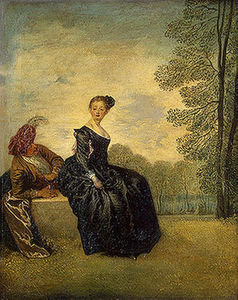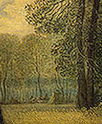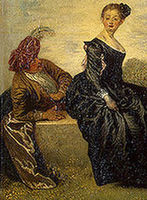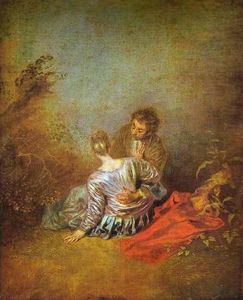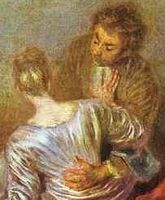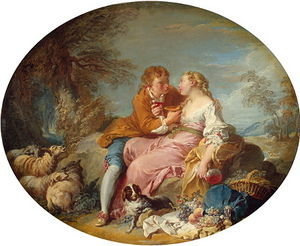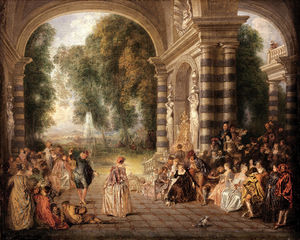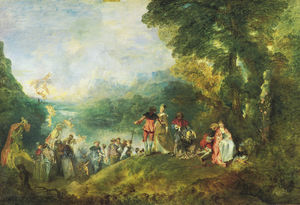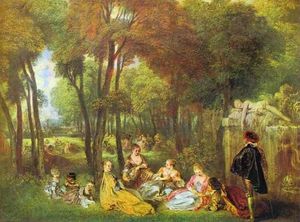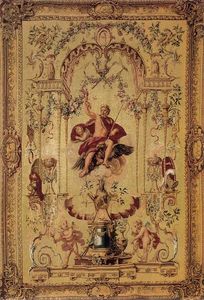La Boudeuse
- Date of Creation:
- circa 1718
- Alternative Names:
- The Capricious Girl
- Medium:
- Oil
- Support:
- Canvas
- Subject:
- Figure
- Art Movement:
- Rococo
- Created by:
- Current Location:
- Saint Petersburg, Russian Federation
- Displayed at:
- State Hermitage Museum
- Owner:
- State Hermitage Museum
- La Boudeuse Page's Content
- Story / Theme
- Inspirations for the Work
- Analysis
- Related Paintings
- Artist
- Art Period
- Bibliography
La Boudeuse Story / Theme
Much unlike his other, happier works where his characters enjoy the gayness of the festivities, Watteau's La Boudeuse or Capricious Girl tells a tale of thwarted, frustrated love.
The girl appears flirty by nature but her posture reveals a haughtier attitude. She sits up straight, her back turned to her pursuer. One must take note of her flustered cheeks - perhaps the gentleman behind her has said something flirtatious to embarrass her. Maybe her interests are peaked and the flushing of her cheeks reveals her excitement. Or, it is possible that the man has gone too far and has said something to enrage her.
It could be that the moment before she was facing him - but now, annoyed with his inappropriateness, she has turned her back refusing to look at him, her posture now rigid.
Conversely, the man's posture is of the opposite nature. He leans on his arm, head cocked, staring at her. At best he's hoping that she will relax even if it's just enough to turn her head slightly to look him in the eyes, or even better, give him a wink. He's waiting for some kind of signal, but it seems even his patience is about to run out.
La Boudeuse Inspirations for the Work
Love was often the inspiration for all of Watteau's works. He relished in the actions, expressions and feelings that came about with love.
The artist sometimes displayed happy lovers; women flirting with their suitors, feigning interest, or he showed scenes where the woman was not interested in the man at all.
La Boudeuse, also called the Capricious Girl, is often translated as the flirtatious girl. Though her stance seems rigid and unwilling, perhaps Watteau wants us to read further into her flushing cheeks.
La Boudeuse Analysis
La Boudeuse is perhaps Watteau's most blatant portrayal of love. With no kooky characters from the Commedia dell'Arte, no musicians, and without bright wardrobes to distract the viewers, Watteau's intended frustration is obvious with just the young girl and man to focus on.
Composition:
The canvas is closer to a square, a change from the more rectangular works common for Watteau. He positions the anxious couple to the left of the square, their bodies filling a fifth of the frame.
A sparse landscape is in the distant foreground. Like the majority of Watteau's paintings, the perspective is head-on.
Tone:
The smug face and strict upright position of the young girl creates a subtly hostile mood. This is especially noticeable in contrast to the lax pose of the man behind her. The difference in their attitudes exemplifies the sexual frustration looming in the air.
Brushstroke:
Watteau's brushstroke in La Boudeuse creates a thick texture.
Color palette:
True to the style of Rococo, Watteau paints with a warm, neutral palette. The colors play quite nicely together and blend well, except for the light blue peaking out through the clouds.
Lighting:
The uppermost part of the painting is brighter than the lower portion. The girl's face is the most lit, her pursuer's face (just a head beneath her) a little less dim, and finally the remainder of her dress the least dimly lit.
La Boudeuse Related Paintings
La Boudeuse Artist
Perhaps one of the more innocent of the group, La Boudeuse is often categorized under collections pertaining to the seduction of 18th century art in France. The works of these collections are seen as erotic but could easily slip over into the pornographic. As the decent becomes indecent, such works were often not revealed to the public.
La Boudeuse seems innocent with its fully clothed, sexually frustrated couple. It does not bring about the shock value that perhaps Pierre Subleyras' 1732 A Scene of an Artist Painting a Seal of Chastity on his Wife from a Tale by Jean de La Fontaine would. Critics view Watteau's work as mild, but as a magnificent display the frustrations passion, desire and seduction can bring about.
The many aspects of erotic desire were explored by artists and devoured by connoisseurs, private collectors and the French public alike.
Jean-Antoine Watteau is attributed to extending the bounds of the 18th century French-born Rococo at period beyond architecture, furniture and sculpture and into painting.
In his short career he was attributed to developing a unique style and revolutionizing the art world through his individuality. This was seen not only in the themes of his theatrically-influenced work but also in his ornate and airy style.
Watteau's influence on the art world, encompassing costume, film, poetry, music was more extensive than that of almost any other eighteenth century artist. He had many followers during his career but also a lot of critics. Despite his reputation diminishing with the fall of Rococo, it was restored after the French Revolution.
La Boudeuse Art Period
Watteau was a key player in the 18th century Rococo art movement. The word Rococo is a combination of the French rocaille, or shell, due to the heavy usage of shell-like curves, and the Italian barocco, or Baroque style for its decorative nature.
Its style emergence was first displayed in the decorative arts and interior design before Watteau adapted it toward painting aesthetics. Louis XV's succession brought a change in the court artists and general artistic fashion.
By the end of the old king's reign, rich Baroque designs were giving way to lighter elements with more curves and natural patterns. These elements are obvious in the architectural designs of Nicolas Pineau.
During the Régence, court life moved away from Versailles and this artistic change became well established, first in the royal palace and then throughout French high society. The delicacy and playfulness of Rococo designs is often seen as perfectly in tune with the excesses of Louis XV's regime.
Rococo painting, as well as most French art of the 18th century was light, airy, frilly and bejeweled, which is fitting as it was intended for the powerful aristocracy and wealthy upper-middle class.
Watteau's artistic content could be summarized by two major influences: his love for the theater and his fascination of the Rococo styling and design. Spending his early years in Paris in the workshop of set designer Claude Gillot, Watteau gained his love for the theater, specifically for the Italian Commedia dell'Arte and its innumerable characters.
Shortly after, he worked for interior designer Claude Audran III and picked up Rococo design influences.
Watteau's attraction to Rococo's curving lines and decorative nature became central to his later work. As his career progressed the artist combined his love for the theater and his fascination of the Rococo styling and design and developed a truly unique style of painting with ornate elegance that gained him critical attention.
La Boudeuse Bibliography
To find out more about Watteau and his works please choose from the following recommended sources.
• Lauterbach, Iris. Antoine Watteau: 1684-1721. PLACE, 2008
• Mollett, John William. Watteau. Kessinger Publishing, LLC, 2007
• Perl, Jed. Antoine's Alphabet: Watteau and His World. Random House, 2008
• Posner, Donald. Antoine Watteau. Cornell University Press, 1984
• Rogers, Robert Emmons. Behind A Watteau Picture: A Fantasy in Verse in One Act. Kessinger Publishing, LLC, 2007
• Sheriff, Mary D. Antoine Watteau: Perspectives on the Artist and the Culture of His Time. University of Delaware Press, 2006
• Stranahan, C. H. A History of French Painting From the Earliest To It's Latest Practice. Charles Scribner's Sons, 1918
• Zeri, Federico. Watteau: The Embarkation for Cythera. NDE Publishing, 2000

